Last Updated on September 6, 2023 by Tim Wells
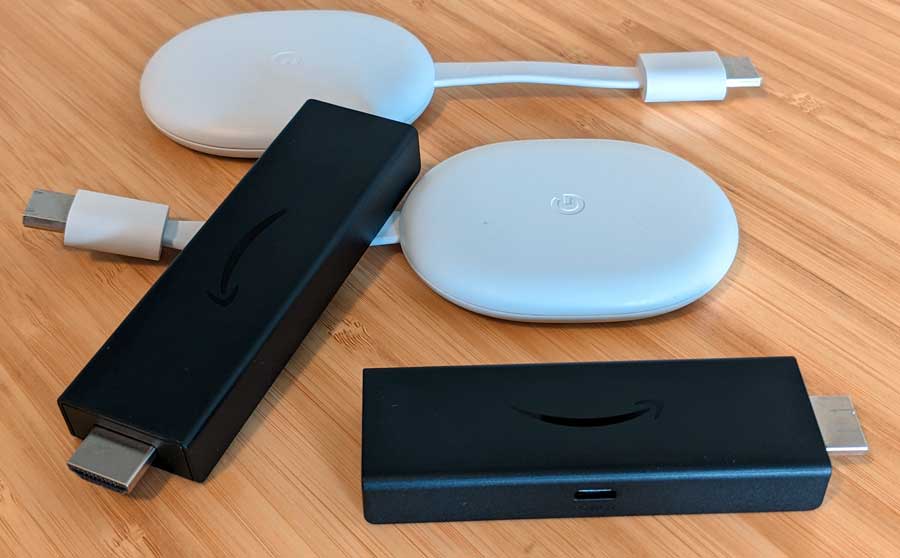
Looking to upgrade your streaming experience and are torn between Chromecast and FireStick? Even then…which version do you go with?
Choosing the right streaming device can be overwhelming.
Don’t worry.
That’s why we’ve put together this comprehensive comparison.
We’ll look at all six models of the Chromecast with Google TV and Amazon’s Fire TV Stick. We’ll focus on the features that matter most to streamers like you.
Let’s dive into our Chromecast vs. FireStick showdown and find the perfect streaming companion for you!
| Product Image | Product Name / Price | Primary Button |
|---|---|---|
|
||
|
||
|
||
|
Choosing the Right Model: Overview
The Chromecast and Fire TV Stick lineups are split into two categories: 4K and HD streaming devices. Each category has three current models: two FireSticks and one Chromecast.
Chromecast vs. Firestick: 4K Models Showdown
If you’re looking for a budget 4K streaming device, it’s hard to go wrong with any of these three devices. This section will cover the Chromecast with Google TV 4K, FireStick 4K Max, and Fire TV Stick 4K.
The Amazon FireStick 4K Max has a slight edge when it comes to performance, thanks to a slightly faster processor and DDR4 RAM. This means smoother streaming and a snappier interface.
It’s worth noting that the Chromecast with Google TV 4K and Fire TV Stick 4K are no slouches. They provide most users a solid streaming experience and perform well on independent benchmark tests.
| Chromecast with Google TV 4K | Fire TV Stick 4K Max | Fire TV Stick 4K | |
| Release Year | 2020 | 2021 | 2018 |
| Android Version | 12 | 9 | 7.1 |
| Processor | Quad-Core 1.9 GHz | Quad-Core 1.8 GHz | Quad Core 1.7GHz |
| Memory (RAM) | 2 GB DDR3L | 2GB DDR4 | 1.5GB DDR4 |
| Storage | 8 GB | 8 GB | 8 GB |
| Resolution | Up to 4K @ 60fps | Up to 4K @ 60fps | Up to 4K @ 60fps |
| Video Supported | HDR10, HDR10+, HLG, Dolby Vision | HDR10, HDR10+, HLG, Dolby Vision | HDR10, HDR10+, HLG, Dolby Vision |
| Audio Supported | Dolby Atmos, AC3 (Dolby Digital), eAC3 (Dolby Digital Plus) | Dolby Atmos, AC3 (Dolby Digital), eAC3 (Dolby Digital Plus) | Dolby Atmos, AC3 (Dolby Digital), eAC3 (Dolby Digital Plus) |
| Colors | Snow White, Sunrise Pink, Sky Blue | Black | Black |
All three devices have excellent video performance, offering 4K resolution at 60 fps and support for HDR formats like HDR10, HDR10+, HLG, and Dolby Vision.
If great audio quality is more your thing, the Chromecast with Google TV 4K and FireStick 4K Max have you covered. Both support Dolby Atmos, Dolby Digital, and Dolby Digital Plus audio formats for a more immersive experience. The older Fire TV Stick 4K has similar audio support but only offers Dolby Atmos via passthrough.
Although these streaming devices aren’t geared toward gamers, the FireStick 4K Max performs better for more demanding games. The Chromecast with Google TV 4K and Fire TV Stick 4K offer some gaming options, but they may not perform as smoothly.
If you need a streaming device that stands out from the crowd, the Chromecast with Google TV 4K has three color options. It’s available in Snow White, Sunrise Pink, and Sky Blue. The FireStick models, on the other hand, sport a basic black design that easily blends into your entertainment setup.
Chromecast vs. Firestick: HD Models Comparison
Now let’s look at the HD contenders: Chromecast with Google TV HD, Fire TV Stick, and Fire TV Stick Lite.
While these models may not offer the same 4K resolution as their counterparts, they still provide an enjoyable streaming experience at a more affordable price.
Performance-wise, there isn’t a significant difference between the three devices. They all have quad-core processors and 8GB of storage. However, Amazon uses a proprietary CPU, so no benchmark can run on all three devices.
| Chromecast with Google TV HD | Fire TV Stick | Fire TV Stick Lite | |
| Release Year | 2022 | 2020 | 2020 |
| Android Version | 12 | 9 | 9 |
| Processor | Quad-Core 1.5 GHz | Quad Core 1.7GHz | Quad Core 1.7GHz |
| Memory (RAM) | 1.5 GB DDR3L | 1 GB DDR4 | 1 GB DDR4 |
| Storage | 8 GB | 8 GB | 8 GB |
| Resolution | Up to 1080p HDR, 60 fps | Up to 1920 x 1080 (1080p) – 60Hz | Up to 1920 x 1080 (1080p) – 60Hz |
| Video Supported | HDR10, HDR10+, HLG | HDR10, HDR10+, HLG | HDR10, HDR10+, HLG |
| Audio Supported | Dolby Digital, Dolby Digital Plus, Dolby Atmos (passthrough) | Dolby Atmos, AC3 (Dolby Digital), eAC3 (Dolby Digital Plus) | HDMI Audio passthrough for Dolby Digital, Dolby Digital+, Dolby Atmos, and DTS |
| Colors | Snow White | Black | Black |
That said, the Fire TV Stick and Fire TV Stick Lite have a slight edge. Both have 1.7GHz processors and DDR4 RAM. This offers a marginally faster streaming experience than the Chromecast with Google TV HD’s older AmLogic s805X 1.5GHz processor and DDR3L RAM.
All three devices support 1080p resolution at 60Hz, so your favorite movies and TV shows look great on your TV. Each device also includes HDR support for HDR10, HDR10+, and HLG.
The Chromecast with Google TV HD and Fire TV Stick both support Dolby Atmos, Dolby Digital, and Dolby Digital Plus for immersive sound experiences. While not offering Dolby Atmos, the Fire TV Stick Lite still provides HDMI audio passthrough for Dolby Digital, Dolby Digital+, and DTS.
Unlike its 4K bigger brother, the Chromecast with Google TV HD only comes in a Snow White color. The Fire TV Stick and Fire TV Stick Lite come in a basic black design that blends into your living room.
All three devices offer a decent casual gaming experience but don’t expect the same performance as their 4K counterparts. Thanks to their slightly faster processors and DDR4 RAM, the Fire TV Stick, and Fire TV Stick Lite may handle games a bit better than the Chromecast with Google TV HD.
Chromecast vs. Firestick: Interface
In the past few years, Amazon and Google rolled out new home screen interfaces for their streaming devices. Although they’ve both taken a ‘content first’ approach, how they implement it is different.
Amazon Fire TV
The Amazon Fire TV home screen and interface have gone through various iterations over the years. Recent updates brought significant changes to its layout and navigation.
In this section, we’ll discuss navigating the Fire TV interface and how easy it is to find the content you’re looking for.
The latest Fire TV update introduced a new navigation menu with icons instead of text labels to give it a clean, modern look. The menu consists of the user profile icon, a search icon (magnifying glass), Home, Free, Live, and My Stuff tabs.
The newly added “My Stuff” tab is a welcome change. This makes it easier to access your watchlist, purchases, rentals, and DVR recordings if you have a Fire TV Recast.
When you highlight an icon in the navigation menu, you get a video preview of the content in the bottom half of the screen. This makes it seem faster when you’re clicking around the interface.
However, the “Find” tab, now represented by a magnifying glass icon, has been trimmed down from four rows to two. Some smaller sections have been removed, leaving major sections like Free, Movies, Comedies, and Sci-Fi. While this may streamline the interface, it can also limit discoverability for users interested in niche genres.
The new “Free” tab lists rows of content available for free streaming, but it has some quirks.
The Fire TV interface doesn’t show you which streaming service offers free content. This makes it difficult for users to know where the content is coming from.
Some content listed as “free” may be available only through a paid service offering a free trial, which can be frustrating for users expecting genuinely free content.
Despite this, I like the Amazon Fire TV interface. It looks good, and most users find it relatively easy to navigate. The revamped menu, content previews, and especially the new “My Stuff” tab improve the overall user experience.
However, the limitations in the “Find” and “Free” tabs may require users to put in some extra effort to find what they want.
Chromecast with Google TV
Google TV, which launched with the Chromecast 4K, is an evolution of the older Android TV interface. While it was popular with enthusiasts, the average user found it difficult to find what they wanted.
The newer Google TV home screen prioritizes a content-first approach, making it easier for users to find and watch their favorite shows and movies without opening individual apps.
The main “For you” tab includes a prominent carousel with top releases, themed content, and occasional ads. The “Top Picks for you” section of the screen suggests content based on your viewing habits.
Google TV streamlines navigation by consolidating features into one location.
For example, the “Continue watching” row combines content from multiple streaming apps, allowing users to quickly resume their shows.
Depending on your setup, the interface also features dedicated tabs for Live TV, Library, and the Google Watchlist. The Library tab houses rented and purchased movies. The Google Watchlist enables users to curate a single watchlist that syncs across devices.
Google TV recently added four new content pages: Movies, Shows, Family, and Español. These pages provide users quick access to family-friendly titles, movies, TV shows, and Spanish-language entertainment.
Google also made some other enhancements to the Google TV interface recently. These include relocating the profile switcher to the top left corner, moving the search function to the far right of the navigation bar, and introducing a quick settings button.
Overall, the Google TV interface provides a modern, user-friendly experience that puts content front and center. It reduces the number of steps needed to find and watch your favorite shows and movies.
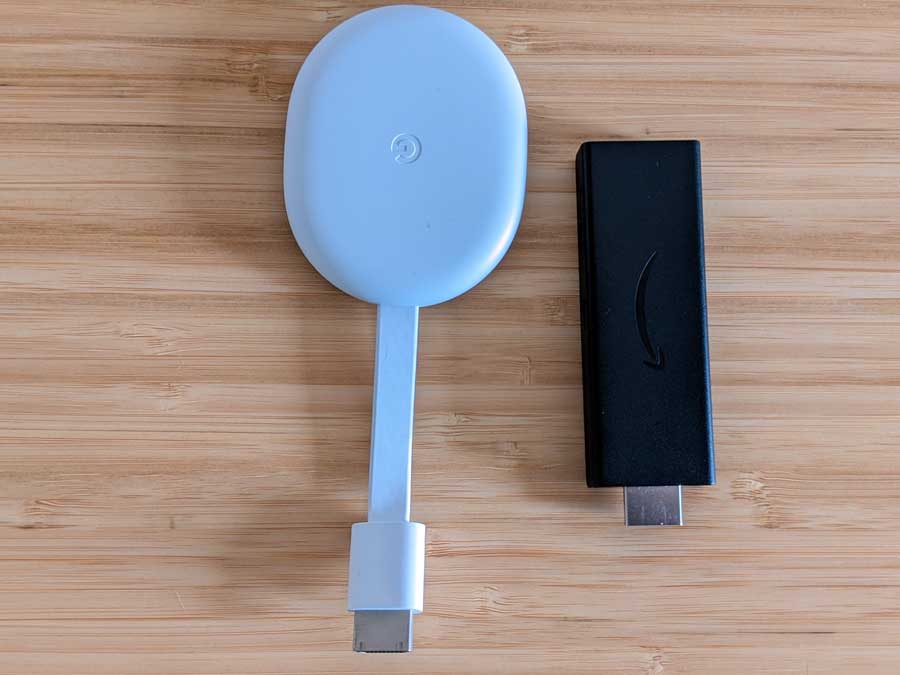
Other Important Features
Specs and performance aren’t everything. Sometimes, other features can make all the difference when choosing a streaming device.
Here are some features we think you should consider.
Voice Assistants: Alexa vs. “OK Google”
As you can imagine, Google Assistant and Alexa are the key technologies powering the Chromecast and the FireStick. You’re probably at least somewhat familiar with these digital assistants.
But, as a streaming device user, you should be aware of some features that can enhance your entertainment experience.
Both Google Assistant and Alexa allow users to control their streaming devices with voice commands. This includes playing and pausing content and controlling the volume. These controls work on most popular streaming services like Netflix, Hulu, and HBO.
Alexa on the FireStick offers seamless integration with Amazon’s Prime Video, while Google Assistant on the Chromecast supports YouTube and YouTube Music.
Both voice assistants can create multi-room audio systems with compatible smart speakers or displays. Google Assistant can also help transfer your music between different smart speakers and displays as you move around the house. Alexa, unfortunately, doesn’t offer a similar feature.
Google Play Store vs. Amazon App Store
To install new apps, you’ll be using the Google Play Store and Amazon App Store. Both stores have apps designed specifically for TV and streaming devices.
That said, there are differences in their offerings and user experiences.
The Google Play Store has a more extensive collection of apps than the Amazon App Store. It includes most of the popular streaming services, games, and utility apps. While the Amazon App Store also offers a good selection of apps, it is more limited. However, it’s worth noting that anything you find on the Amazon App Store will be specifically optimized for the Fire TV platform.
Obviously, the Amazon App Store allows the FireStick to integrate better with Amazon services, such as Prime Video and Amazon Music. Similarly, the Google Play Store offers the Chromecast with seamless access to Google services like YouTube, YouTube Music, and Google Play Movies & TV.
Both stores have a review process to ensure the quality of apps available for download. However, most developers consider the Google Play Store to have a more stringent review process. Additionally, since Fire TV OS is a fork of the open-source Android OS, the Amazon App Store will have fewer apps overall.
To sum up, the Google Play Store offers a broader range of apps and better integration with Google services, while the Amazon App Store caters to the Amazon ecosystem and provides a tailored experience for Fire TV users.
Chromecast vs. Firestick: Which Should You Buy?
Choosing between the Chromecast and Firestick largely comes down to personal preference. Compared to devices like Roku streaming sticks or Android boxes, both offer a much better experience.
Still, depending on your situation, we can offer some recommendations:
For budget-conscious users, both the Amazon Firestick Lite and Chromecast with Google TV HD offer excellent value for money. If you only need HD content and want the simplest streaming device, go with the Firestick Lite. Although the Chromecast with Google TV HD has slightly better features, the FireStick Lite is more affordable.
If you want the widest selection of apps possible, choose either Chromecast model. There’s really no comparing the sheer volume of apps available in the Google Play Store.
At the high end, both the FireStick 4K Max and the Chromecast with Google TV 4K support high-quality video (up to 4K) and audio. Performance is neck-and-neck between both devices. I’m biased toward the Chromecast, but you can’t go wrong either way. It all comes down to which interface you prefer and if Alexa or Google Assistant is better integrated with the devices you already own.
Speaking of Alexa, if you’re heavily invested in smart home automation, the Amazon Firestick with Alexa is a better option. It has broader compatibility with smart home devices.
At the high end, the FireStick 4K Max has a better remote control than the Chromecast with Google TV. It’s great that this is the first Chromecast generation with a remote control, but they still have some work to do to make it more useful.
To sum up, both the Chromecast and Firestick offer outstanding streaming performance at their price points, and each has unique selling points.
When deciding, consider what type of content you prefer, your audio and video setup, and any smart home integration. Ultimately, the choice comes down to which device best aligns with your entertainment needs and personal preferences.
| Product Image | Product Name / Price | Primary Button |
|---|---|---|
|
||
|
||
|
||
|
- How to Install Kodi Diggz Xenon Plus & Free99 Build [March 2024] - March 3, 2024
- How to Enable Unknown Sources on Chromecast with Google TV [2024] - October 30, 2023
- How to Install the Seren Kodi Addon [2024] - October 29, 2023

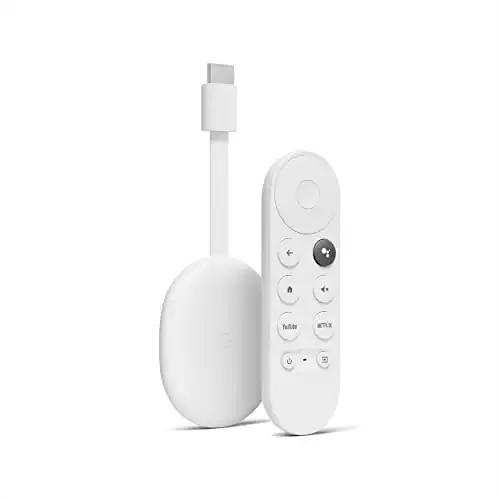
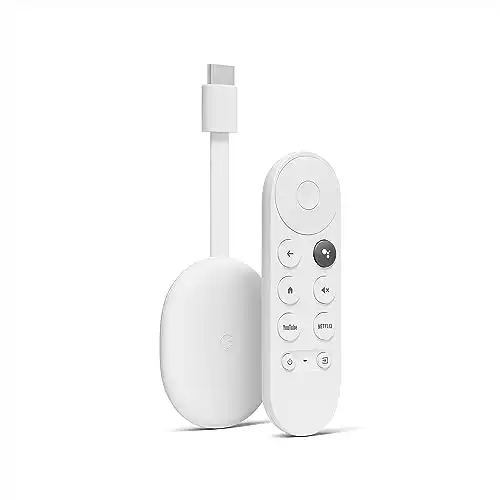
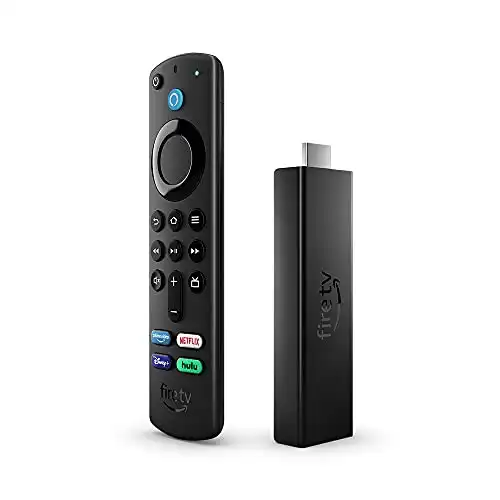
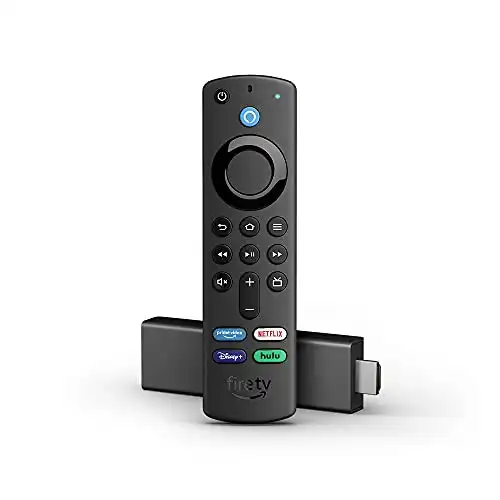
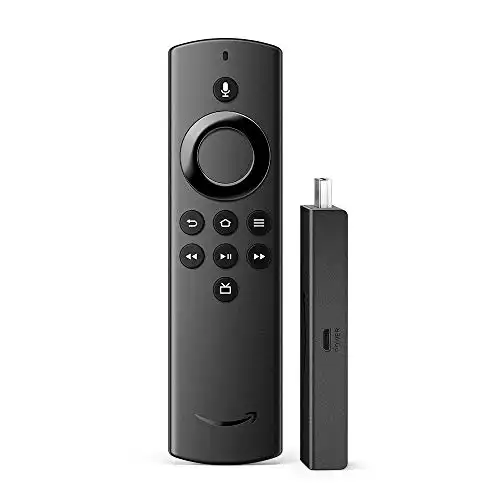
![Amazon Fire TV Cube [Latest Version]](https://androidtvnews.com/wp-content/uploads/2023/09/51TJe7E4LYL._SL500_.webp)
